White delphiniums are stunning perennials that add a touch of elegance and charm to any garden. Known for their towering spikes of white blossoms, they make excellent focal points or companions in mixed flower beds. Growing and caring for white delphiniums requires some attention, but the effort is well worth the reward of their beautiful blooms. In this blog, we’ll dive deep into how to grow and care for these gorgeous plants.
Quick Reference Table: White Delphinium
| Common Name | White Delphinium |
| Botanical Name | Delphinium spp. |
| Family | Ranunculaceae |
| Plant Type | Herbaceous perennial |
| Mature Size | 4–6 feet tall, 1–3 feet wide |
| Sun Exposure | Full sun to partial shade |
| Soil Type | Rich, well-drained soil |
| Soil pH | Neutral to slightly alkaline (6.5–7.5) |
| Hardiness Zones | 3–7 |
| Native Area | Northern Hemisphere |
| Toxicity | Toxic to humans and pets |
Planting and Transplanting White Delphinium
White delphiniums thrive in rich, well-drained soil and full sun. Knowing when and how to plant them is the first step to success. Here’s a step-by-step guide:
When to Plant
- Spring Planting: Sow seeds or plant seedlings in early spring after the last frost.
- Fall Planting: For regions with mild winters, plant in autumn to allow roots to establish before winter dormancy.
Site Selection
Choose a location that receives at least 6 hours of sunlight daily. In hot climates, partial afternoon shade helps prevent scorching.
How to Plant
- Prepare the Soil: Delphiniums need nutrient-rich soil. Add compost or well-rotted manure to enrich the planting area.
- Spacing: Space plants 1–3 feet apart to allow good air circulation and prevent diseases.
- Planting Depth: For seeds, sow them 1/8 inch deep. For transplants, plant them at the same depth as they were in their pots.
- Watering: Water thoroughly after planting to settle the soil around the roots.
Transplanting Tips
- Transplant seedlings when they have 2–3 sets of true leaves.
- Handle gently to avoid damaging the roots.
- Water well immediately after transplanting.
White Delphinium Care
Caring for white delphiniums involves providing consistent water, proper feeding, and occasional staking to support their tall growth.
Watering
- Consistency is Key: White delphiniums prefer evenly moist soil. Avoid letting the soil dry out completely or become waterlogged.
- Deep Watering: Water deeply once or twice a week, depending on weather conditions.
Fertilizing
- Spring Feed: Use a balanced fertilizer (10-10-10) when new growth emerges.
- Midseason Boost: Apply a high-potassium fertilizer during blooming to encourage vibrant flowers.
Mulching
Apply a 2–3 inch layer of organic mulch around the base to retain moisture, regulate soil temperature, and suppress weeds.
Staking
Due to their height, delphiniums are prone to flopping. Use stakes or plant supports to keep them upright, especially in windy areas.
Types of White Delphinium
Several varieties of white delphinium are available, each with unique features. Here are a few popular options:
1. Delphinium elatum ‘Galahad’
- Height: Up to 6 feet
- Features: Pure white flowers with a prominent central bee (flower center)
- Ideal for: Borders and cutting gardens
2. Delphinium x belladonna ‘Snow Lace’
- Height: 3–4 feet
- Features: Semi-double flowers with a light, airy appearance
- Ideal for: Smaller spaces or mixed borders
3. Delphinium ‘Casablanca’
- Height: 4–6 feet
- Features: Fully double flowers in snowy white
- Ideal for: Elegant garden displays
Pruning
Pruning white delphiniums helps promote continuous blooming and healthy growth.
Deadheading
- Remove spent blooms promptly to encourage a second flush of flowers later in the season.
- Cut the flower stalks down to the base or to a healthy leaf node.
Cutting Back
- After the first frost, cut plants down to 6–8 inches above ground level.
- Dispose of pruned material to prevent pests and diseases from overwintering.
Propagating White Delphinium
White delphiniums can be propagated by seeds, division, or cuttings.
Seed Propagation
- Collect seeds from mature flowers in late summer.
- Sow seeds in seed trays filled with a sterile starting mix. Keep the soil moist and place trays in a cool location.
Division
- Divide established plants every 3–4 years in early spring.
- Carefully dig up the plant and separate the root clumps using a sharp knife.
Stem Cuttings
- Take 3–4 inch cuttings from young, healthy stems in spring.
- Dip the cut end in rooting hormone and plant in moist, well-draining soil.
Potting and Repotting White Delphinium
White delphiniums can thrive in containers with proper care.
Potting Tips
- Choose a large pot with good drainage holes.
- Use a high-quality potting mix amended with compost.
Repotting
- Repot every 2–3 years or when roots become crowded.
- Refresh the soil with nutrient-rich mix during repotting.
Overwintering
Protect white delphiniums during winter, especially in colder zones.
Steps for Overwintering
- Cut back stems to 6–8 inches after the first frost.
- Apply a thick layer of mulch (4–6 inches) to insulate the roots.
- In very cold regions, consider covering plants with burlap or frost cloth.
Common Problems With White Delphinium
1. Powdery Mildew
- Symptoms: White, powdery spots on leaves.
- Solution: Improve air circulation, avoid overhead watering, and use a fungicide if necessary.
2. Root Rot
- Symptoms: Yellowing leaves and stunted growth.
- Solution: Ensure well-draining soil and avoid overwatering.
Common Pests & Plant Diseases
Pests
- Aphids: Cause curling leaves and sticky residue.
- Control: Spray plants with insecticidal soap.
- Slugs and Snails: Feed on tender foliage.
- Control: Use slug traps or apply diatomaceous earth around plants.
Diseases
- Black Spot: Causes dark lesions on leaves.
- Solution: Remove infected leaves and apply a fungicide.
How to Get White Delphinium to Bloom
Key Tips
- Provide 6–8 hours of sunlight daily.
- Use high-potassium fertilizer during the growing season.
- Deadhead spent flowers to encourage new blooms.
FAQ
Q: Are white delphiniums toxic?
Yes, all parts of the plant are toxic if ingested by humans or pets.
Q: How long do white delphiniums live?
With proper care, they can live 5–7 years.
Q: Can I grow white delphiniums indoors?
They are best suited for outdoor gardens but can grow indoors in large pots with ample sunlight.
Q: Do white delphiniums attract pollinators?
Yes, they attract bees, butterflies, and hummingbirds.
Read also: Sweet Peas: How to Grow and Care for Sweet Peas










